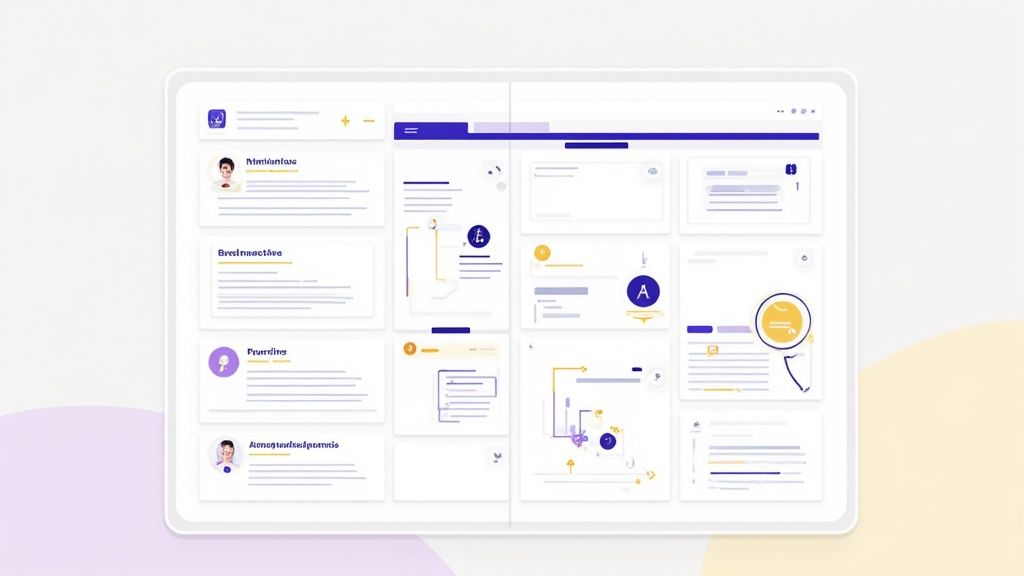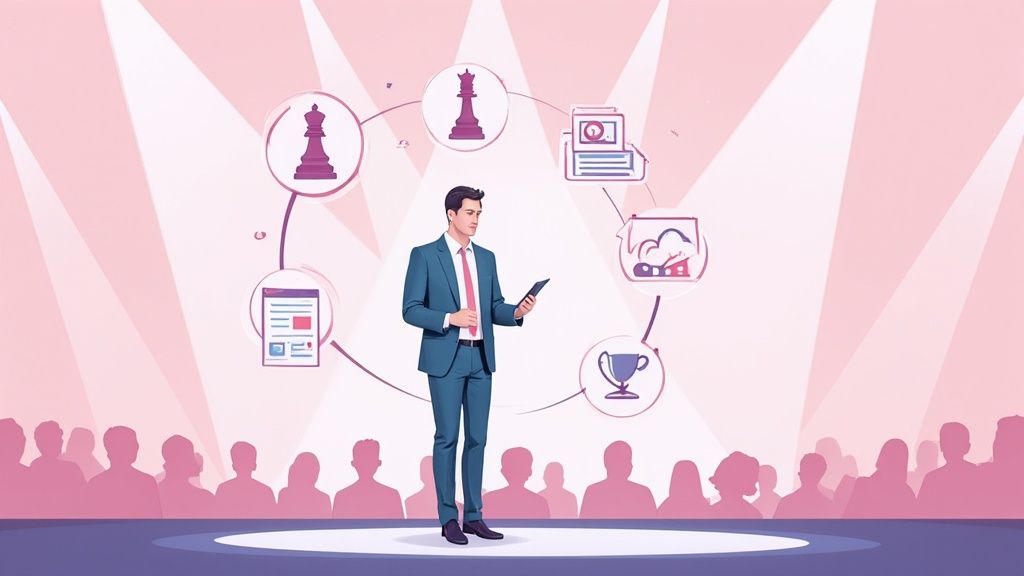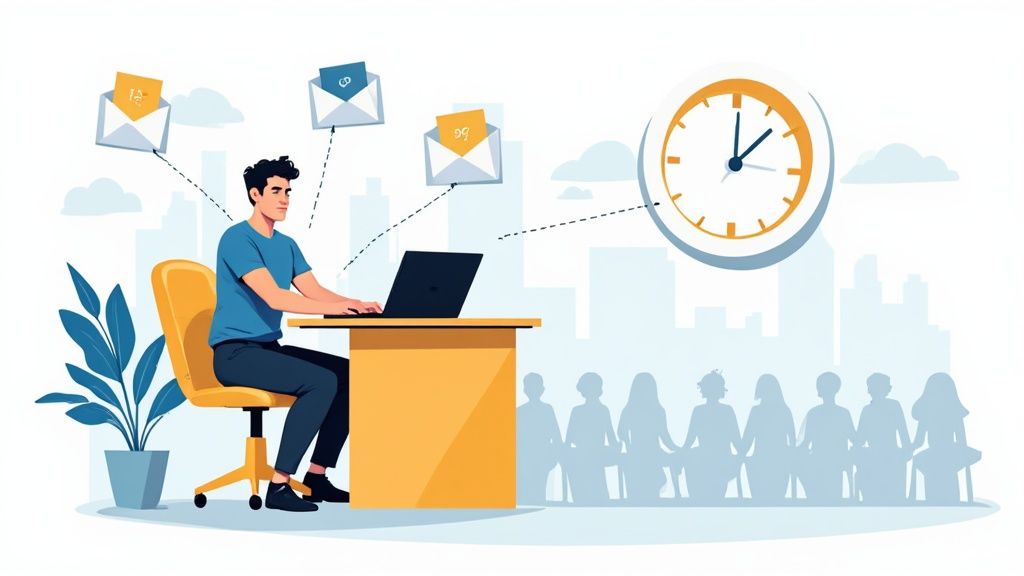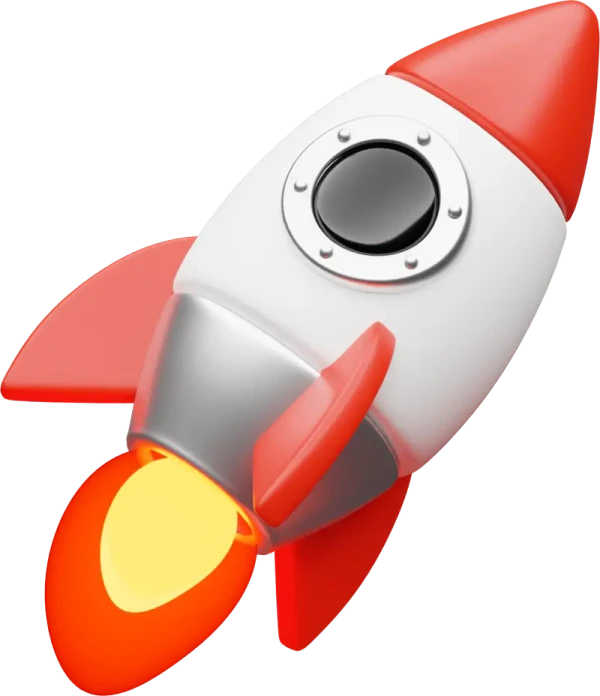Why Your Event Description is Your Most Crucial Marketing Tool
An event description is more than just an announcement; it's your first, and often only, chance to convert interest into attendance. It's the digital handshake, the virtual hype-man, and the persuasive argument all rolled into one. A weak description leads to empty seats and missed opportunities, while a powerful one can sell out your venue and create lasting buzz. This is where your marketing truly begins.
In this comprehensive guide, we move beyond generic templates to provide a strategic breakdown of what works. We will dissect 7 distinct event description examples, covering everything from corporate conferences to music festivals and weddings. You will see firsthand how to apply specific formulas, tones, and persuasive tactics to captivate vastly different audiences.
Get ready to transform your event pages from simple information portals into powerful conversion engines. We will explore the precise language that drives action, the structural elements that build anticipation, and the key details that eliminate friction for potential attendees. By the end, you'll have a playbook of replicable strategies to craft compelling descriptions that not only inform but also inspire and convert. Let’s dive into the examples that will make your next event a success.
1. Corporate Conference Description
A corporate conference description serves as a powerful marketing tool designed to attract professionals by clearly articulating the event's value. Unlike more casual event write-ups, these descriptions are strategic, focusing on tangible business outcomes, learning opportunities, and high-value networking. The core goal is to convince potential attendees that the time and financial investment will yield a significant return, whether through new skills, valuable connections, or critical industry insights. These are some of the most crucial event description examples because they must appeal to a discerning audience focused on professional growth.
Great examples include the descriptions for Salesforce's Dreamforce, which masterfully blends inspiration with practical, role-specific learning tracks, or the concise, benefit-driven copy for Harvard Business School's executive programs. These descriptions succeed by moving beyond logistics to sell a vision of professional transformation.
Strategic Breakdown
An effective corporate conference description operates on three levels: authority, value, and exclusivity. It establishes the event's authority through expert speakers and data-driven content. It communicates value with clearly defined learning outcomes and promises of actionable strategies. Finally, it creates a sense of exclusivity by highlighting unique networking opportunities with industry leaders and peers. This approach frames attendance not as an expense, but as a strategic career investment.
For a quick reference on what to prioritize, this summary highlights the essential components of a high-impact corporate description.
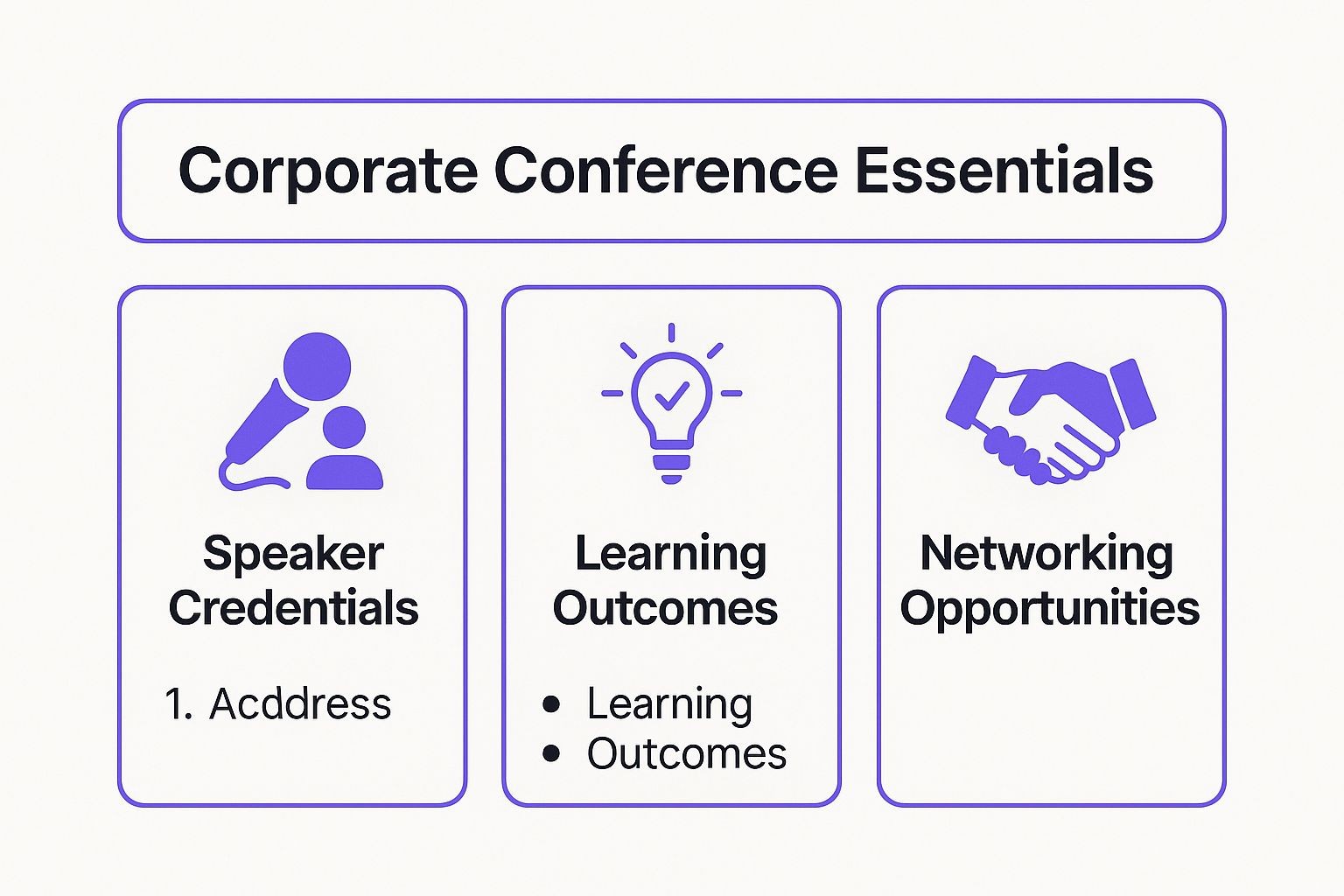
As the visual guide shows, a balanced focus on who is speaking, what will be learned, and who you will meet is the formula for a compelling pitch.
Actionable Takeaways
- Lead with the "Why": Start with a bold statistic or a pressing industry challenge. For example, "90% of marketing leaders struggle with AI integration. Our conference provides the roadmap."
- Be Specific About Outcomes: Replace vague promises with concrete benefits. Instead of "Learn about marketing," use "Master three new frameworks for calculating customer lifetime value."
- Use Social Proof: Incorporate testimonials from past attendees, especially those in leadership roles. A quote like, "The connections I made at last year's event led to our most profitable partnership," is incredibly persuasive.
- Structure for Scannability: Use bullet points, bold text, and short paragraphs to highlight key speakers, session titles, and networking events. This helps busy professionals quickly assess the event's value. Once you've secured their interest, you'll need a reliable way to manage attendance; you can discover more about event attendance tracking on add-to-calendar-pro.com.
2. Music Festival Description
A music festival description is an immersive and energetic narrative designed to sell an experience, not just a lineup of artists. Unlike a standard concert announcement, it focuses on building a world around the event, evoking feelings of community, freedom, and sensory delight. The goal is to transport the potential attendee into the festival grounds before they even buy a ticket, using vivid language to paint a picture of the atmosphere, the art installations, and the shared moments that make the event unique. These event description examples are crucial for promoters because they must generate powerful FOMO (Fear of Missing Out) and justify a premium ticket price.
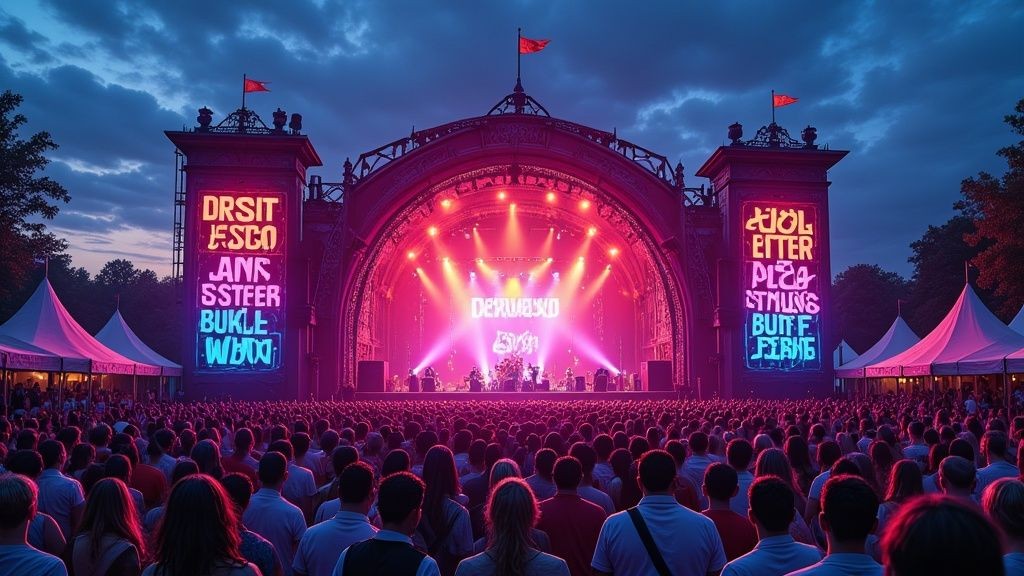
Iconic examples include the descriptions for Coachella, which masterfully sells a desert oasis fantasy, or Glastonbury, which emphasizes its legendary history and eclectic, counter-culture spirit. These descriptions succeed by creating a powerful brand identity that transcends the annual artist roster, making the festival itself the main attraction.
Strategic Breakdown
An effective music festival description operates on a foundation of atmosphere, discovery, and community. It establishes the atmosphere with sensory language describing the sights, sounds, and energy of the venue. It promises discovery by highlighting not just the headliners but also emerging artists, unique food vendors, and interactive art. Finally, it builds a sense of community by speaking directly to the "tribe" of attendees, referencing shared values and past experiences to create a feeling of belonging. This strategy frames the ticket as an entry pass to a temporary, magical world.
For a quick reference on what to prioritize, this summary highlights the essential components of a captivating festival description.
As this visual guide illustrates, a compelling festival pitch balances the sensory experience, the scheduled attractions, and the feeling of collective participation.
Actionable Takeaways
- Sell the Vibe, Not Just the Roster: Start with the feeling. For example, "Escape reality and find your rhythm under the electric sky," before diving into the artist list.
- Use Sensory and Action-Oriented Words: Replace passive descriptions with dynamic language. Instead of "There will be music and art," use "Dance to earth-shaking bass, lose yourself in mesmerizing light shows, and discover interactive art around every corner."
- Create Urgency and Exclusivity: Emphasize tiered ticketing and sell-out warnings. Phrases like, "Tier 1 tickets are 90% sold out! Secure your spot before they’re gone," drive immediate action.
- Highlight the "More Than Music" Elements: Mention unique food experiences, wellness workshops, camping culture, or sustainability initiatives. Beyond the lineup, mentioning logistical details like dedicated minibus hire for music festivals can attract more attendees by promising a hassle-free experience.
3. Charity Fundraising Event Description
A charity fundraising event description is crafted to connect with attendees on an emotional level, inspiring them to contribute to a cause. Unlike transactional event copy, these descriptions prioritize storytelling and empathy to drive action. The primary objective is to make potential donors feel a personal stake in the mission, transforming their attendance from a simple social outing into a meaningful act of support. These are vital event description examples because their success is measured not just in attendance, but in tangible community impact and funds raised.
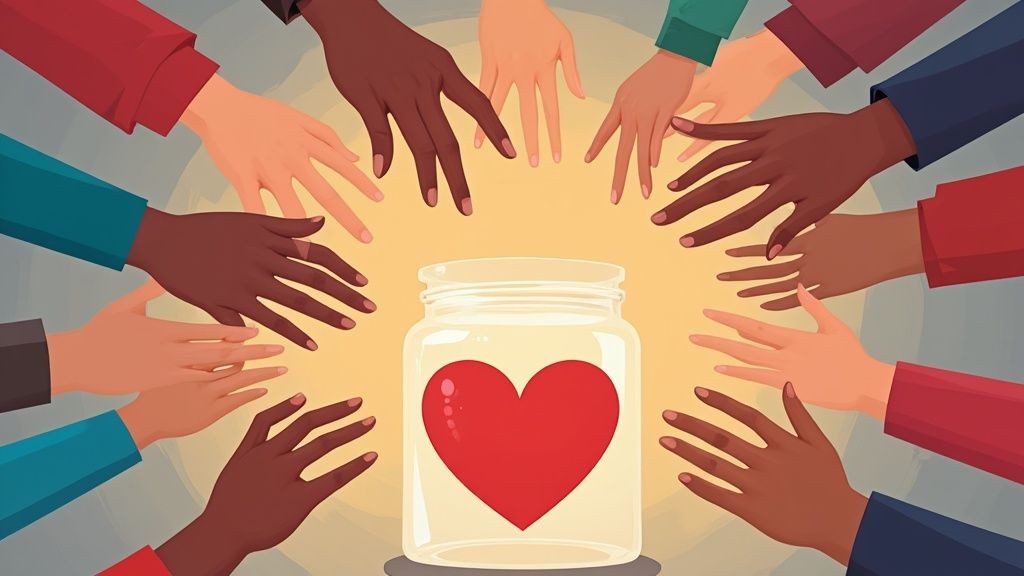
Successful examples from organizations like St. Jude Children's Research Hospital or Habitat for Humanity masterfully blend poignant narratives with clear, concrete data about where donations go. They convince attendees that their presence and contribution will create a direct, positive change in someone's life, making the event feel both impactful and essential.
Strategic Breakdown
An effective charity event description operates on a foundation of emotion, transparency, and urgency. It builds an emotional connection by sharing a compelling personal story of someone helped by the organization. It establishes trust through transparency, clearly stating how funds will be used with specific impact numbers. Finally, it creates urgency by framing the event as a critical opportunity to make a difference right now, turning passive interest into active participation and donation. This strategy ensures the message resonates deeply, motivating attendees to give generously.
The visual guide above reinforces this formula: lead with heart, prove the impact with data, and guide supporters toward a clear action. This balanced approach is key to inspiring generosity.
Actionable Takeaways
- Start with a Story: Begin with a short, compelling narrative about an individual or family. For instance, "Meet Sarah, a single mother who found stable housing for her children thanks to last year's gala attendees."
- Show the Direct Impact: Be specific about how donations translate into results. Instead of "Your donation helps," use "A $50 ticket provides 100 hot meals for our city's homeless." This makes the value of a contribution tangible.
- Create a Clear Call-to-Donate: Make the giving process seamless within the description. Include a prominent button or link with direct text like, "Join Us: Reserve Your Seat and Change a Life Today."
- Highlight the Experience: While the cause is central, also promote the event itself. Mention key attractions like a special musical guest, a silent auction with unique items, or an inspiring keynote speaker to show that giving back is also an enjoyable experience.
4. Wedding Event Description
A wedding event description transforms a simple invitation or announcement into a heartfelt narrative that shares a couple's love story with their guests. Unlike transactional event details, these descriptions aim to create an emotional connection, setting the tone for the celebration and making guests feel like they are part of something truly special. The goal is to blend romance with practicality, weaving together the story of the couple with essential logistical information. These are deeply personal event description examples that prioritize intimacy and connection over formal marketing.

Excellent examples can be found on wedding websites hosted on platforms like The Knot, where couples often share "Our Story" sections, or in the detailed descriptions for destination weddings that paint a picture of the unique setting. These descriptions succeed by making guests feel cherished and excited to witness a key moment in the couple’s journey.
Strategic Breakdown
An effective wedding event description balances three core elements: narrative, atmosphere, and logistics. It establishes the narrative by sharing a brief, engaging anecdote about the couple's relationship. It builds atmosphere by using descriptive language to evoke the feeling of the venue and the style of the celebration, whether it's a rustic barn wedding or an elegant city affair. Finally, it provides clear logistics, ensuring guests know where to be and when, without detracting from the romantic tone. This approach makes guests feel both emotionally invested and well-informed.
Actionable Takeaways
- Tell a Mini-Story: Start with a short, sweet story about how you met or the proposal. For example, "From a chance meeting at a coffee shop to a proposal under the stars, our love story has been an adventure. We can't wait to start the next chapter with you."
- Describe the Vibe: Use sensory details to describe the atmosphere. Instead of "Join us at our wedding," try "Join us for an evening of celebration under the twinkling lights of the historic Grand Ballroom."
- Mention Special Details: If you're including a unique tradition, cultural element, or a special tribute, mention it briefly. This gives guests context and makes them feel more involved.
- Clarify Guest Actions: Be clear about what guests need to do, especially regarding RSVPs. Streamlining this process is crucial; to simplify this, you can find out how to create an RSVP link on add-to-calendar-pro.com to manage responses effortlessly.
5. Food Festival Description
A food festival description is a sensory-driven narrative designed to entice attendees by appealing directly to their taste buds and love for culinary exploration. Unlike more formal announcements, these descriptions use vivid, mouth-watering language to paint a picture of gastronomic delight. The primary objective is to make potential visitors feel hungry and excited, transforming the idea of the event into an unmissable culinary adventure. These are powerful event description examples because they must translate abstract flavors into compelling, tangible reasons to attend.
Excellent examples can be found in the marketing for the South Beach Wine & Food Festival, which expertly highlights celebrity chef appearances alongside decadent tasting opportunities, or the Taste of Chicago, which emphasizes the sheer diversity and scale of its offerings. These descriptions succeed by focusing on the experience, evoking the sights, smells, and tastes that await attendees.
Strategic Breakdown
An effective food festival description is built on three pillars: sensation, exclusivity, and community. It stimulates the senses with descriptive words like “smoky,” “zesty,” and “velvety.” It creates exclusivity by showcasing unique dishes, limited-time offerings from renowned chefs, or special food and drink pairings. Finally, it fosters a sense of community by framing the event as a shared celebration of local culture, craft, and flavor. This strategy positions the festival not just as a place to eat, but as a vibrant cultural gathering.
A compelling food festival description should be well-supported by a strong digital presence. You can find inspiration by reviewing some of the best event landing page examples on add-to-calendar-pro.com to see how visuals and copy work together.
Actionable Takeaways
- Use Sensory Language: Go beyond listing food types. Instead of "Tacos and Burgers," write "Savor hand-pressed tortillas filled with smoky, slow-braised barbacoa and gourmet burgers with aged cheddar and truffle aioli."
- Highlight the Talent: Spotlight the chefs, mixologists, and artisans behind the food. Mention their credentials, awards, or a signature dish they are famous for. "Meet James Beard Award winner Chef Elena who will be serving her legendary lobster risotto."
- Create Urgency with Exclusives: Mention one-day-only dishes, special tasting flights, or limited-availability collaborations. This encourages immediate ticket purchases and creates fear of missing out.
- Address Practical Concerns: Clearly state if there are vegetarian, vegan, or gluten-free options available. Mentioning dietary accommodations broadens your audience and shows you are inclusive and well-prepared.
6. Tech Conference Description
A tech conference description is engineered to attract a highly specialized and discerning audience of developers, innovators, and industry leaders. It goes beyond a simple schedule, acting as a beacon for those eager to engage with the future of technology. These descriptions must communicate cutting-edge content, exclusive access to experts, and hands-on learning opportunities. The primary goal is to convince tech professionals that attending is essential for staying relevant, gaining a competitive edge, and connecting with the brightest minds in the field.
Prime examples include descriptions for events like Apple's WWDC, which promises a first look at new software, or TechCrunch Disrupt, which frames its event as the epicenter of startup innovation. These event description examples succeed by speaking the language of their audience, emphasizing not just what will be shown, but what can be built, solved, and discovered. They sell access to the bleeding edge of technological advancement.
Strategic Breakdown
An effective tech conference description is built on three core pillars: innovation, application, and connection. It showcases innovation by highlighting breakthrough technologies, keynote speakers who are pioneers in their fields, and exclusive announcements. It demonstrates practical application through detailed agendas of hands-on workshops, code labs, and technical sessions. Finally, it facilitates connection by emphasizing networking events, "ask me anything" sessions with experts, and opportunities to meet venture capitalists or potential collaborators.
This strategy ensures the description appeals to both the visionary and the pragmatist. It promises attendees not only a glimpse into the future but also the specific tools and contacts needed to build it themselves, making attendance feel like a critical career accelerator.
Actionable Takeaways
- Be Explicit About Technologies: Name the specific languages, frameworks, and platforms being featured. Instead of "Learn about AI," use "Deep dive into generative AI with PyTorch 2.0 and large language model optimization."
- Segment by Technical Level: Clearly label sessions for "Beginner," "Intermediate," or "Advanced" audiences. This helps attendees build a relevant schedule and shows you respect their time and expertise.
- Highlight "Firsts" and "Exclusives": Emphasize what is unique to your event. Use phrases like "World-first reveal," "Exclusive hands-on demo," or "Be the first to code with the new API."
- Showcase the Human Element: Feature speaker bios that highlight their real-world contributions and open-source projects. Mention specific networking zones or events designed to foster meaningful conversations, not just business card exchanges.
7. Sports Event Description
A sports event description is engineered to capture raw emotion and high-stakes energy, translating the thrill of the game into compelling copy. Unlike other event write-ups, these descriptions thrive on immediacy, rivalry, and spectacle. The primary goal is to build intense anticipation and foster a sense of shared identity among fans, urging them to be part of a historic moment. The language is dynamic and evocative, designed to make a potential attendee feel the roar of the crowd and the weight of every play before they even arrive. These are essential event description examples for anyone marketing live competitions, as they must sell an experience, not just a ticket.
Prime examples include the Super Bowl's epic, narrative-driven promotional materials that frame the game as a battle of titans, or the FIFA World Cup's descriptions that tap into national pride and global unity. Local marathons also excel here, focusing on personal challenge and community spirit to inspire participation. These descriptions succeed by transforming a game into a must-see cultural event.
Strategic Breakdown
An effective sports event description is built on three pillars: stakes, spectacle, and community. It establishes high stakes by highlighting historic rivalries, championship implications, or record-breaking opportunities. It communicates spectacle by focusing on star players, the electric venue atmosphere, and unique fan experiences. Finally, it creates a sense of community by using inclusive language ("your team," "our city") that unites supporters under a common banner. This strategy positions attendance as an act of loyalty and a chance to witness greatness.
For a quick reference on what to prioritize, this summary highlights the essential components of a high-impact sports description. It balances the competitive narrative with the tangible fan experience, creating a powerful call to action that resonates with die-hard supporters and casual viewers alike.
Actionable Takeaways
- Amplify the Rivalry: Frame the event around a compelling narrative. For example, "A decade-long rivalry comes to a head. Can the reigning champs defend their title, or will the underdog finally claim victory?"
- Use Action-Oriented Language: Employ powerful verbs and vivid adjectives to create a sense of motion. Instead of "The teams will play," use "Witness a colossal clash as titans collide on the field."
- Highlight Key Players and Stats: Mention star athletes and compelling statistics to add credibility and excitement. "See a living legend in action as she attempts to break the all-time scoring record."
- Describe the Fan Experience: Go beyond the game itself. Mention pre-game festivities, unique food and drink options, or special halftime shows. This paints a fuller picture of the event's value and helps justify ticket prices.
Event Description Comparison of 7 Examples
| Event Type | Implementation Complexity 🔄 | Resource Requirements ⚡ | Expected Outcomes 📊 | Ideal Use Cases 💡 | Key Advantages ⭐ |
|---|---|---|---|---|---|
| Corporate Conference | Medium - requires detailed speaker research and agenda planning | High - expert speakers, professional design | High - credibility, professional networking, learning | Business professionals, executives, specialists | Establishes authority, clear ROI, builds trust |
| Music Festival | High - frequent lineup updates, vibrant content | Medium - artist coordination, marketing | High - emotional excitement, strong engagement | Large public festivals, cultural events | Builds anticipation, appeals emotionally |
| Charity Fundraising Event | Medium - careful storytelling and fact-checking | Medium - cause data, emotional content | Medium to High - donations, awareness, community support | Non-profits, fundraising campaigns | Motivates giving, emotional connection |
| Wedding Event | Low to Medium - personal story and logistics updates | Low - personal input, event details | Medium - guest engagement, memorable celebration | Personal celebrations, intimate/social gatherings | Creates connection, sets expectations |
| Food Festival | Medium - vendor coordination, sensory language | Medium - chef/vendor involvement | Medium - foodie appeal, local business support | Culinary events, local food culture | Creates sensory anticipation, community building |
| Tech Conference | High - technical content, workshops, expert speakers | High - tech experts, innovation demos | High - industry authority, knowledge sharing | Professional tech audience, innovation focus | Showcases innovation, professional networking |
| Sports Event | Medium - dynamic content reflecting teams/players | Medium - player stats, fan engagement | High - excitement, fan loyalty, strong emotions | Competitive sports, fan-focused events | Builds community, drives emotional engagement |
Turn Your Perfect Description into Guaranteed Attendance
Throughout this guide, we've deconstructed a wide array of event description examples, moving far beyond generic templates. We’ve explored the strategic thinking required to craft compelling narratives for everything from high-stakes corporate conferences and vibrant music festivals to heartfelt charity galas and intimate weddings. The core lesson is clear: an effective event description is never just a list of details. It's a strategic blend of psychology, marketing, and storytelling tailored with precision to a specific audience.
We saw how tech conferences use FOMO (Fear of Missing Out) and exclusivity to drive registrations, while food festivals sell a sensory experience. The common thread weaving through all successful examples is a deep empathy for the attendee. What are their motivations? What problems are they trying to solve? What kind of experience are they craving? Answering these questions is the first step toward transforming a simple announcement into an irresistible invitation.
From Words to Action: Your Strategic Blueprint
Mastering the art of the event description requires a synthesis of the tactics we've analyzed. To ensure your efforts translate into a full house, focus on these foundational pillars:
- Embrace the "WIIFM" Principle: Always answer the "What's In It For Me?" question from your audience's perspective. Whether it's career advancement, unparalleled entertainment, or the chance to support a noble cause, lead with value.
- Segment and Personalize: The language that resonates with a tech developer is vastly different from what attracts a festival-goer. As demonstrated in our event description examples, speaking your audience's language builds instant rapport and trust.
- Structure for Scannability: Use bold headers, concise bullet points, and short paragraphs. Modern readers scan first and read second. Your description must capture their attention in seconds and guide them effortlessly to the most crucial information, like the date, location, and key benefits.
- Create a Clear Path to Conversion: Every description needs a powerful and unambiguous Call to Action (CTA). Whether it's "Register Now," "Buy Tickets," or "RSVP Today," make the next step obvious and easy to take.
Beyond the Description: Securing Commitment
Crafting the perfect description is a monumental achievement, but it's only the first half of the conversion journey. Once you've captured their interest, you must make it incredibly simple for them to commit. This is where you can bridge the gap between intent and action. Beyond crafting a persuasive description, exploring strategies like these top event engagement ideas can significantly boost engagement and attendance. The ultimate goal is to embed your event into the attendee's personal schedule, making it a fixed part of their plans.
Your event description is your most powerful marketing asset. It’s your digital handshake, your first impression, and your primary sales pitch all rolled into one. By applying the strategic insights and tactical breakdowns from the examples provided, you are now equipped to do more than just inform; you are ready to persuade, excite, and convert. Go beyond merely announcing your event, and start selling an experience that no one will want to miss.
Ready to ensure your perfectly crafted event descriptions lead to packed venues? Turn passive interest into active commitment by adding a simple, powerful "Add to Calendar" button to your website, landing pages, and emails. Discover how Add to Calendar PRO can drastically reduce no-shows and make your event an unmissable, scheduled part of your audience's lives.
